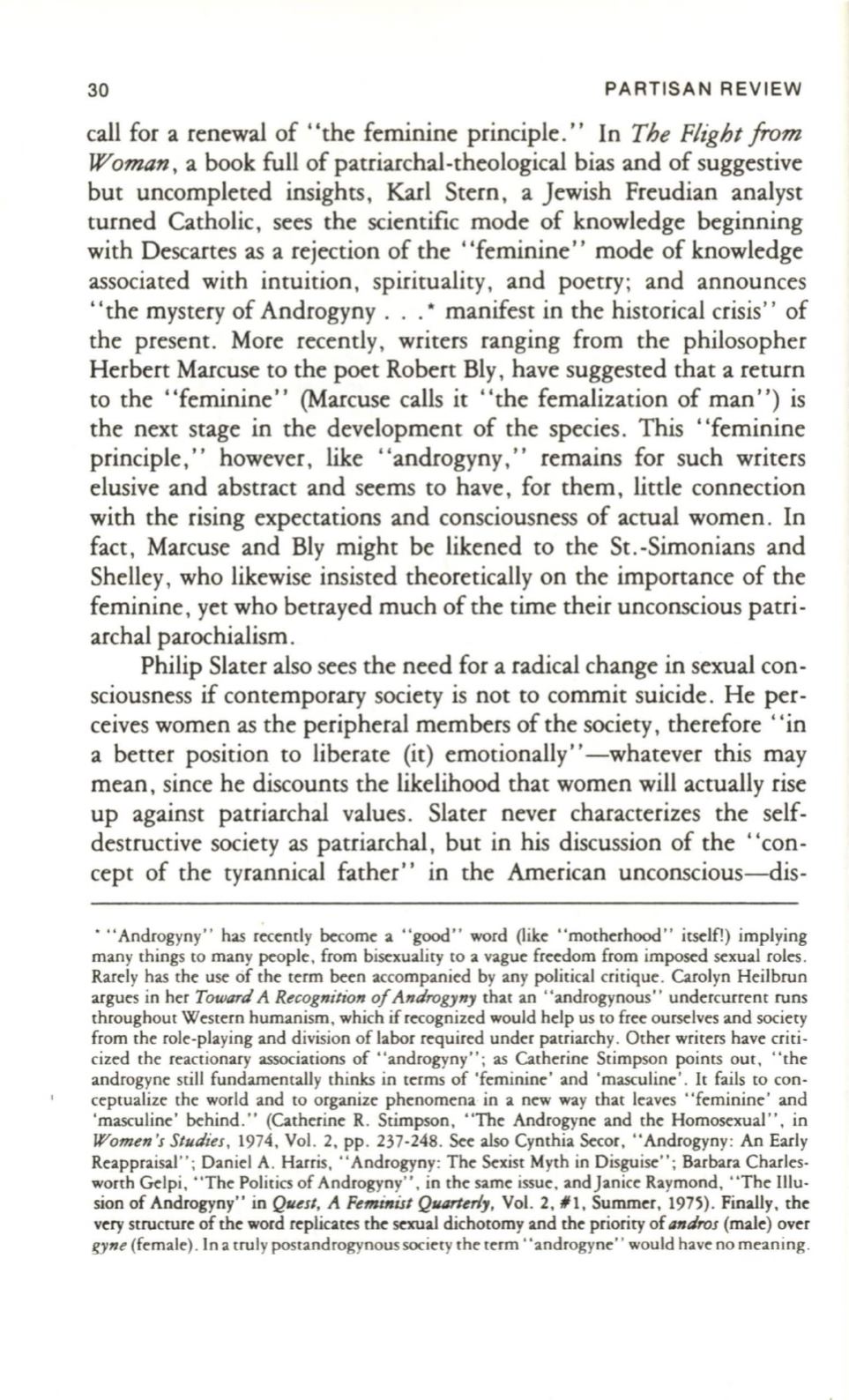
30
PARTISAN REVIEW
call for a renewal of "the feminine principle." In
The Flight from
Woman,
a book full of patriarchal-theological bias and of suggestive
but uncompleted insights, Karl Stern, a Jewish Freudian analyst
turned Catholic, sees the scientific mode of knowledge beginning
with Descartes as a rejection of the "feminine" mode of knowledge
associated with intuition, spirituality, and poetry; and announces
"the mystery of Androgyny . ..
*
manifest in the historical crisis" of
the present. More recently, writers ranging from the philosopher
Herbert Marcuse to the poet Robert Bly, have suggested that a return
to the "feminine" (Marcuse calls it "the femalization of man") is
the next stage in the development of the species. This "feminine
principle," however, like "androgyny," remains for such writers
elusive and abstract and seems
to
have, for them, little connection
with the rising expectations and consciousness of actual women. In
fact, Marcuse and Bly might be likened to the St .-Simonians and
Shelley, who likewise insisted theoretically on the importance of the
feminine, yet who betrayed much of the time their unconscious patri–
archal parochialism.
Philip Slater also sees the need for a radical change in sexual con–
sciousness if contemporary society is not to commit suicide. He per–
ceives women as the peripheral members of the society, therefore' 'in
a better position
to
liberate (it) emotionally" -whatever this may
mean, since he discounts the likelihood that women will actually rise
up against patriarchal values. Slater never characterizes the self–
destructive society as patriarchal, but in his discussion of the "con–
cept of the tyrannical father" in the American unconscious-dis-
. "Androgyny" has recently become a "good" word (like "motherhood" itself!) implying
many things
to
many people. from bisexuality
to
a vague freedom from imposed sexual roles.
Rarely has the use of the term been accompanied by any political critique. Carolyn Heilbrun
argues in her
Toward A Recognition ofAndrogyny
that an "androgynous" undercurrent runs
throughout Western humanism. which if recognized would help us
to
free ourselves and society
from the role-playing and division of labor required under patriarchy. Other writers have criti–
cized the reactionary associations of "androgyny"; as Catherine Stimpson points out, "the
androgyne still fundamentally thinks in terms of 'feminine' and 'masculine' .
It
fails to con–
ceptualize the world and to organize phenomena in a new way that leaves "feminine' and
'masculine' behind." (Catherine R. Stimpson, "The Androgyne and the Homosexual", in
Women 's Studies,
1974, Vol. 2. pp. 237-248. See also Cynthia Secor, "Androgyny: An Early
Reappraisal"; Daniel A. Harris, " Androgyny: The Sexist Myth in Disguise" ; Barbara Charles–
worth Gelpi , "The Politics of Androgyny" . in the same issue, and Janice Raymond, "The Illu–
sion of Androgyny" in
Quest, A Feminist Quarterly,
Vol. 2, #1, Summer, 1975). Finally, the
very strucrure of the word replicates the sexual dichotomy and the prioriry of
andros
(male) over
gyne
(female) . In a truly postandrogynoussociety the term' 'androgyne" would have no meaning.


